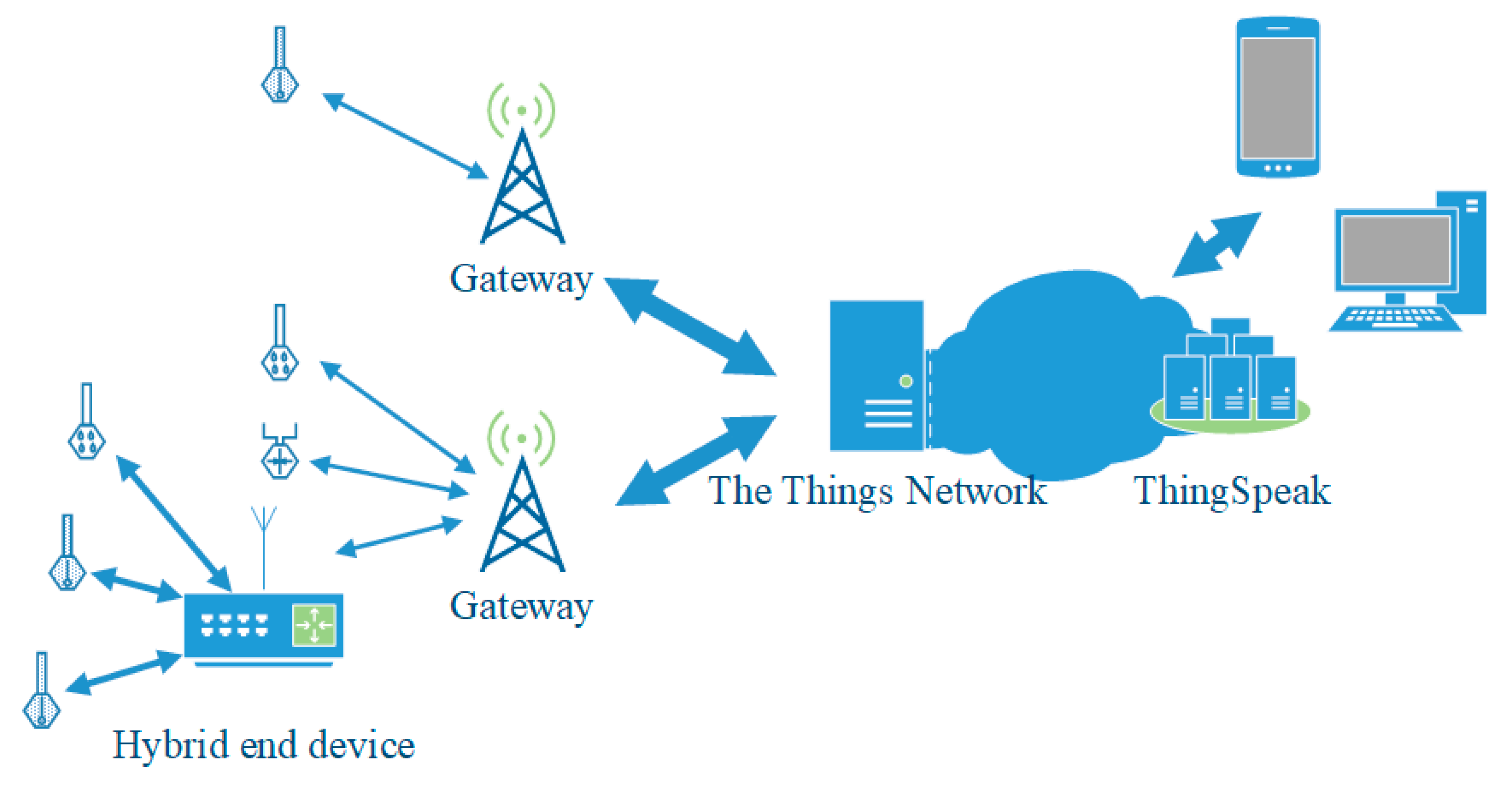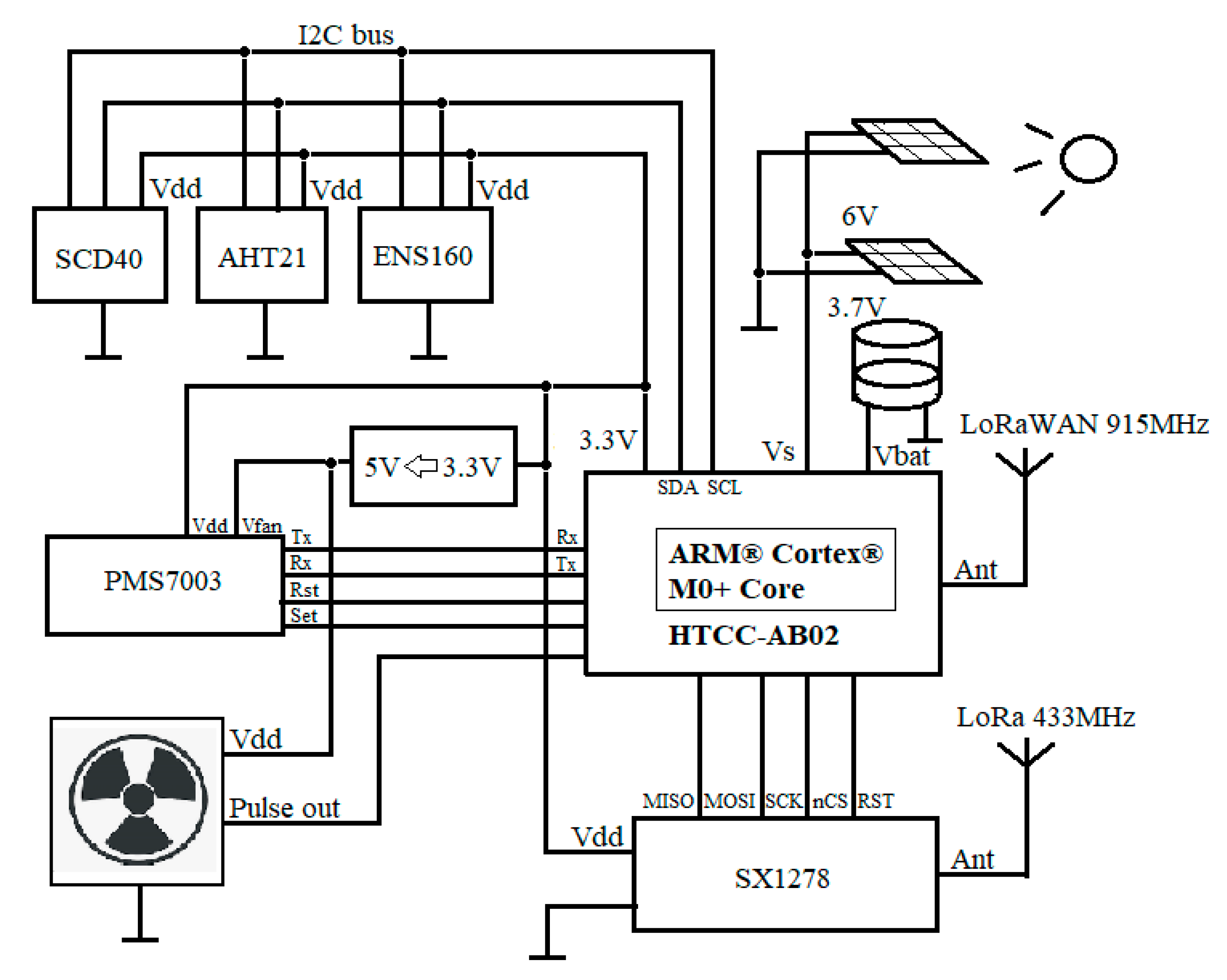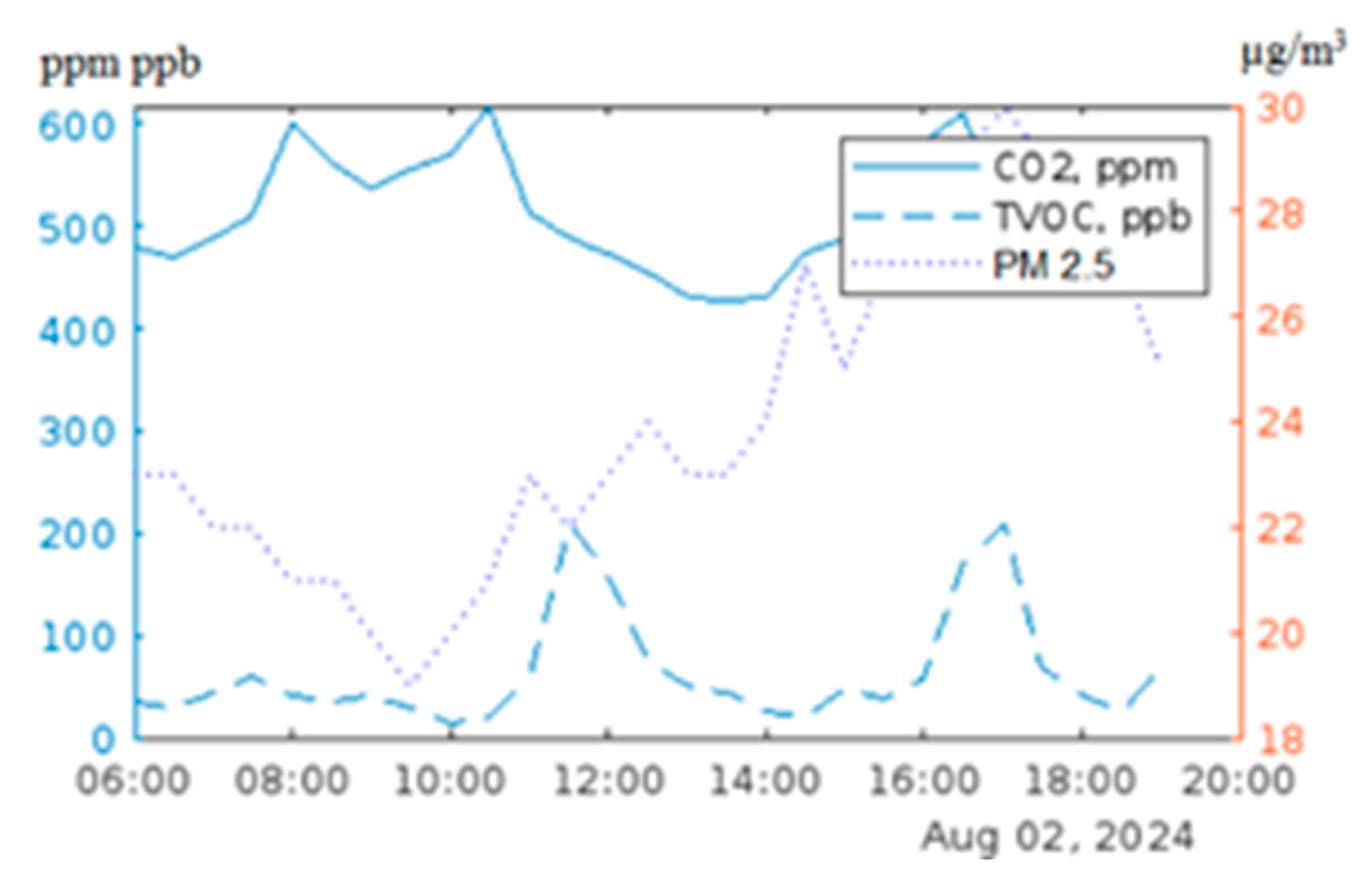1. Introduction
Intelligent transport systems help to better organize and optimize traffic in large cities. In addition to measuring and monitoring traffic parameters in transport systems, an essential aspect of these systems is the monitoring of environmental pollution parameters on roads and the urban transport environment [
1]. Another very important part of these systems is the weather monitoring subsystem. It helps to perform analyses and correlations between traffic intensity, environmental pollution, and weather conditions. Various solutions of environmental monitoring systems can be found in the literature. In [
1], the authors used sensors of the MQ family such as MQ-135 and MQ-9 for sensing, which are controlled by Arduino Mega 2560, and data are stored on an SD card for further processing. The essential drawback of this solution is the use of sensors with high energy consumption. In [
2], the sensors used in their implementation are MQ-135, MQ-136, MQ-9, DHT11, PMS3003, MiCS-4514, and others; but again, the major drawback of their solution is the higher power consumption. In [
3], the authors examined the spatiotemporal variability of urban particulate matter with a network of low-cost air pollution sensors. In this case, the protocols used for wireless communication are based on Wi-Fi and 4G, which are not energy-efficient. In [
4], the proposed real time indoor air quality monitoring system also used a communication protocol based on Wi-Fi.
The present work aims to overcome this drawback with using low-energy consumption digital sensors, a LoRaWAN module with low power consumption, and more effective real-time response communication. On the other hand, LoRaWAN gateways can be overloaded with too much traffic when too many devices are used in small urban areas. For this reason, new communication architectures are needed to overcome this problem.
There are different solutions in the literature like multihop networks that extend the coverage area and improve energy efficiency [
5]. Because of the Aloha-like nature of LoRaWAN, there are some efforts made for improving reliability under large-scale deployments [
6].
This work presents the architecture and implementation of a novel hybrid, dual-band IoT system based on LoRa and LoRaWAN as well the development of a hybrid LoRaWAN end device. The rest of the article is organized as follows: In
Section 2, a new extended architecture of the system is proposed. In
Section 3, the implementation of a hybrid LoRaWAN end device is presented. The initial results from real test monitoring of environmental parameters are presented in
Section 4. Finally, the conclusion and ideas for future work are presented.
2. System Architecture
To overcome the abovementioned problems, we propose an extended architecture of the system presented in
Figure 1. It is based on the classical LoRaWAN architecture, which consists of end devices connected to gateways, the network server, and the application server.
In this case, the role of the network server plays is that it offers The Things Network (TTN) cloud service. It communicates with ThingSpeak, which is an open IoT platform with MATLAB R2016b analytics, and is used to integrate TTN. The developed hybrid end device creates a custom LoRa network for end devices with environmental sensors, which operate in the 433 MHz band. The hybrid end device works as a master, and the end devices that communicate with it are slaves. The master sends requests to a selected end device at regular intervals and relays the data to the upper layers of the LoRaWAN network. This allows the network to cover a much broader area of interest without collisions with the 915 MHz LoRaWAN radio band and without traffic data overload.
3. Implementation of the Hybrid End Device
The block diagram of the developed hybrid LoRaWAN end device is presented in
Figure 2. It is powered by a Lithium polymer battery with a capacity of 6600 mAh, which is the main power source for the device. In addition, there are two photovoltaic cells, each with a nominal voltage of 6 V and 1 W power for charging the Lithium battery. The hybrid end device is controlled by a system on module (SoM) CubeCell Dev-Board Plus (HTCC-AB02). The board has an embedded linear regulator for controlling the current that charges the lithium battery. The microcontroller is based on ARM
® Cortex
® M0+ Core processor, operating at 48 MHz. It has 16 Kbites of SRAM and 128 Kbites FLASH memory for the program. The module has an integrated lithium battery management system with an SH1.25–2 battery interface, as well as a solar energy management system that allows the direct connection of solar panels. The hybrid end device collects data for environmental parameters from the connected sensors. The sensors SCD40, AHT21, and ENS160 are connected to the module via an I
2C interface bus operating at 3.3 V.
The SCD40 is a CO2 sensor from Sensirion Corp. Its technology for sensing CO2 is based on photoacoustic non-dispersive infrared spectroscopy. Infrared light at 4260 nm is used, which is absorbed by carbon dioxide molecules, causing excited molecular vibrations. These increase the translational energy, and this leads to a periodic change in pressure in the measuring cell, which is converted into sound waves measured by a micro-electromechanical systems (MEMS) microphone.
The sensor AHT21 is used for temperature and humidity measurement of the ambient air. The two sensors are paired for temperature and humidity compensation and are integrated into one module.
The sensor ENS160 measures total volatile compounds (TVOCs) and equivalent CO2 (eCO2) using a MEMS hotplate coated with a metal oxide semiconductor (MOx). It has a broadband sensitivity for both reducing and oxidizing gases—H2, ethanol, methane, toluene, acetone, n-octane, CO, and formaldehyde.
For particulate concentration measurement, the sensor PMS7003 is used. It employs the Rayleigh scattering effect [
7,
8]. The sensor uses lasers to radiate suspended particles in the air. The concentration of particles is given in three ranges as follows: 0.3 ÷ 1.0 µm, 1.0 ÷ 2.5 µm, and 2.5 ÷ 10 µm, in µgr per cubic meter volume of air. The sensor communicates with the microcontroller via a serial interface.
The gamma ray detector module is based on J305 tube, which supports ionizing radiation measurement from 20 mR/h to 120 mR/h. The output signal is a pulse train. The required supply voltage for the fan, as well as the supply voltage for the particulate matter sensor, is 5 V. Therefore, a pulsed voltage boost converter from 3.3 V to 5 V is added, as shown in
Figure 2. All measured parameters by the sensors are summarized in
Table 1.
The microcontroller module has integrated a SX1262 module on the board that supports LoRaWAN v1.0.2 connection. In the developed hybrid end device, an additional LoRa module SX1278 is added, which is used for the custom LoRa network operating in the 433 MHz band. This LoRa module is connected to the microcontroller using the SPI interface.
4. Results
The developed hybrid LoRaWAN end device and the operation of the system for monitoring the environmental parameters are tested in a real-world scenario. The hybrid end device transmits the measured data to The Thing Network, which acts as a network server. A connection is made to the ThingSpeak platform, where the data is visualized and further processed in MATLAB. The test results of the air parameters monitoring can be seen on the ThingSpeak chart, as shown in
Figure 3. The presented test results were measured during the summer period (2 August 2024) from 6:00 to 19:00 in the city of Plovdiv, at 63 St. Petersburg Blvd. The developed hybrid LoRaWAN device was installed at the traffic monitoring station located on the boulevard. The initial tests were carried out to measure parameters CO2, TVOC, and the concentration of particles in the air as a proof of concept.
5. Conclusions
This paper presents the architecture and implementation of a novel hybrid, dual-band IoT system based on LoRa and LoRaWAN, along with the developed hybrid LoRaWAN device. The initial tests carried out for measurement of some air parameters serve as proof of our concept. Future work includes designing and testing more end devices connected to the developed hybrid LoRaWAN device and the development of a network that can be evaluated in terms of system latency and reliability. One limitation of this study is the use of inexpensive sensors that have not yet been calibrated, and this is a further issue in future investigations.
Author Contributions
Conceptualization, G.S.; investigation, S.L.; resources, S.L. and G.S.; writing—original draft preparation, S.L., G.S. and G.P.; writing—review and editing, G.P.; visualization, S.L.; supervision, G.S. All authors have read and agreed to the published version of the manuscript.
Funding
This research was funded by the European Regional Development Fund within the OP “Research, Innovation, and Digitalization Program for Intelligent Transformation 2021–2027”, Project CoC “Smart Mechatronics, Eco- and Energy Saving Systems and Technologies”, No. BG16RFPR002-1.014-0005.
Institutional Review Board Statement
Not applicable.
Informed Consent Statement
Not applicable.
Data Availability Statement
Not applicable.
Conflicts of Interest
The authors declare no conflicts of interest.
Abbreviations
The following abbreviations are used in this manuscript:
| ITS | Intelligent Transportation Systems |
| LoRa | Long-Range wireless sensor network |
| LoRaWAN | Long-Range Wide Area Network |
| IoT | Internet of Things |
| TTN | The Things Network |
| SoM | System on module |
References
- Todorov, A.; Gicheva, P.; Stoykova, V.; Karapetkov, S.; Uzunov, H.; Dechkova, S.; Zlatev, Z. Environmental Monitoring in Bus Transportation Using a Developed Measurement System. Urban Sci. 2023, 7, 90. [Google Scholar] [CrossRef]
- Waheb, A.J.; Thanasrii, S.; Andre, E.O.; Mohd, I.S.; Wenyan, W.; Oliveira, M.A. LoRaWAN-Based IoT System Implementation for Long-Range Outdoor Air Quality Monitoring. Internet Things 2022, 19, 100540. [Google Scholar]
- Feinberg, S.N.; Williams, R.; Hagler, G.; Low, J.; Smith, L.; Brown, R.; Garver, D.; Davis, M.; Morton, M.; Schaefer, J.; et al. Examining spatiotemporal variability of urban particulate matter and application of high-time resolution data from a network of low-cost air pollution sensors. Atmos. Environ. 2019, 213, 579–584. [Google Scholar] [CrossRef] [PubMed]
- Taştan, M.; Gökozan, H. Real-Time Monitoring of Indoor Air Quality with Internet of Things-Based E-Nose. Appl. Sci. 2019, 9, 3435. [Google Scholar] [CrossRef]
- Cotrim, J.; Kleinschmidt, J. An analytical model for multihop LoRaWAN networks. Internet Things 2023, 22, 100807. [Google Scholar] [CrossRef]
- Garrido-Hidalgo, C.; Roda-Sanchez, L.; Ramírez, F.; Fernández-Caballero, A.; Olivares, T. Efficient online resource allocation in large-scale LoRaWAN networks: A multi-agent approach. Comput. Netw. 2023, 221, 109525. [Google Scholar] [CrossRef]
- Popa, D.; Udrea, F. Towards Integrated Mid-Infrared Gas Sensors. Sensors 2019, 19, 2076. [Google Scholar] [CrossRef] [PubMed]
- Andrews, D.L. Rayleigh Scattering and Raman Effect Theory; Academic Press: Cambridge, MA, USA, 2017; pp. 924–930. ISBN 9780128032244. [Google Scholar]
| Disclaimer/Publisher’s Note: The statements, opinions and data contained in all publications are solely those of the individual author(s) and contributor(s) and not of MDPI and/or the editor(s). MDPI and/or the editor(s) disclaim responsibility for any injury to people or property resulting from any ideas, methods, instructions or products referred to in the content. |
© 2025 by the authors. Licensee MDPI, Basel, Switzerland. This article is an open access article distributed under the terms and conditions of the Creative Commons Attribution (CC BY) license (https://creativecommons.org/licenses/by/4.0/).










